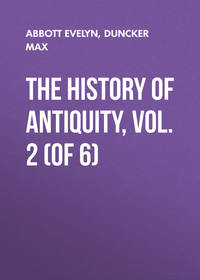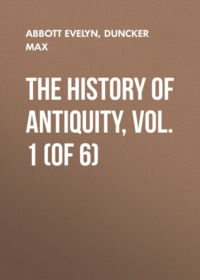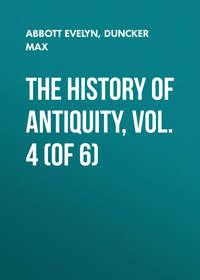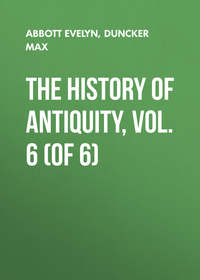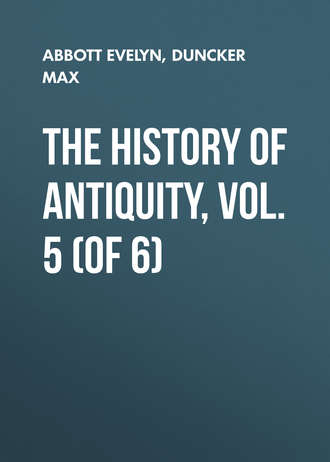 полная версия
полная версияThe History of Antiquity, Vol. 5 (of 6)
We must attempt to reach the goal by another path. I have already shown what was the condition of the sacred scriptures in Iran at the date of Alexander and the Seleucids (p. 55). Even before Hermippus of Smyrna, Aristotle had taught that the Magians considered that to be the best in the first instance which was first created, and maintained two principles, a good and evil deity, Oromazdes and Areimanius.155 Theopompus mentioned both these deities and the strife between them, and when he adds that there would one day be a time when the dead would rise again, and men would be immortal and able to withstand everything by their prayers – that after the victory of Oromazdes men would be happy and need no longer any sustenance, and would cast no shadow156– it will be seen below how definitely and exactly the doctrine of the Avesta is here reproduced. Hermodorus mentions a series of teachers, who succeeded the first teacher of the Magians, the "Persian Zoroaster," down to the campaign of Alexander of Macedon.157 With Eudoxus of Cnidus Zoroaster was the founder of the most beneficent wisdom; the pupils of Prodicus claimed to be acquainted with the writings of Zoroaster (p. 53). Plato calls him the son of Oromazdes, and adds that the heir to the throne was instructed in Magism as well as in the duty of being true during the whole of his life.158 The importance which the Avesta ascribes to truthfulness will become clear hereafter. If the Greeks of the fourth century could speak of Zoroaster as the teacher of the Persians, and put him in the closest relation with Auramazda, if they could reproduce correctly the names of the good and evil spirits and the main doctrines of the Avesta, it is an inevitable conclusion that the religion of Zarathrustra must have prevailed in the kingdom of the Achæmenids.
This result is confirmed by all the further information which we obtain from the Greeks. In Plutarch the last Darius calls on an eunuch, "to tell the truth in reverence for the great light of Mithra"; the eunuch replies that the king has no reason to accuse the evil spirit, and entreats "Lord Oromazdes," "that he may cause the light of the king to shine again."159 Artaxerxes II. was informed by his mother Parysatis that the Persians had received the law which distinguished good and evil from god. He swears "by Mithra," and Plutarch tells us how some related that when Darius, the eldest son of Artaxerxes, who sought his life, was slain, Artaxerxes went into the court of the palace and cried aloud to the Persians: "Rejoice, ye Persians, and tell it to others, that the great Oromazdes has executed judgment on those who imagined crime and wickedness."160 In Plutarch, Artaxerxes I. says to Themistocles: "May Areimanius ever implant such a disposition in my enemies that they may drive from themselves their best and bravest men."161 According to Deinon the Magians prophesied with branches in their hands, sacrificed under the open sky, and looked on fire and water as the only symbols of the divinity.162 Xenophon represents Cyrus as praising the gods and sacrificing to them every morning according to the instructions of the Magians.163 Though Herodotus does not mention either the name of Zarathrustra or of Auramazda, what he says of the rites of the Medes and Persians agrees exactly with the rules given in the Avesta. "Temples, images, and altars," he says, "are not erected by the Persians, because, as it seems to me, they do not believe like the Hellenes that the gods have the form and nature of men. They call the whole circle of heaven Zeus, and offer sacrifice to him after ascending the summits of mountains. Besides Zeus they have from ancient days sacrificed to the sun, the moon, the earth, water, winds, and fire, which among the Persians is a deity:164 the winds they also charm by songs. When offering sacrifice they build no altar and kindle no fire, nor pour libations, nor make any use of flutes, or cakes, or barley meal. If any one wishes to offer sacrifice he brings the victim to an open space, and calls on the god, after crowning his tiara with branches of myrtle. After cutting the animal in pieces, and cooking the flesh, he spreads out the most delicate grass, chiefly trefoil, and lays the flesh upon it. The Magian who stands by sings the theogony over it, for such, according to the Persians, is the nature of the prayer. After some time, the person who has made the sacrifice carries the flesh away and uses it for a feast. The Magians, in whose control is the worship by sacrifice, make it a great object to kill ants, serpents, and other creeping winged things: dogs and men only do they spare. No Persian may pollute a river, nor even wash in it, nor will they allow any one else to do so, for they have a great reverence for rivers. The bodies of the dead may not be burned; it is said indeed that the corpse of a Persian cannot be buried till it has been torn by a dog or a bird, and among the Magians this is an acknowledged practice. It is a meritorious act among the Persians to have many children, and he who can show the most receives gifts each year from the king. Each man celebrates the day on which he was born above all other days. What may not be done, may not be spoken of amongst the Persians: the most shameful action is lying, and the next to this is borrowing, for the reason that a man who has debts is generally compelled to lie. Any one afflicted by the itch or the leprosy may not come into the cities or mix with other Persians; and it is believed that such persons have sinned against the sun-god. Lepers from foreign lands are driven out of the country." When Xerxes came to the Hellespont, and was about to cross the bridge, Herodotus represents him as praying to the sun-god, pouring libations from a golden cup, and throwing it with a golden goblet and a Persian sword into the sea.165 We shall see hereafter to what a degree the killing of noxious animals, the reverence for rivers, the expulsion of lepers, the delight in life and the increase of life, the exposing of dead bodies, and singing of the theogony at sacrifices, correspond to the rules and doctrines of the Avesta. In one point only is Herodotus mistaken: he states that the Persians worshipped a female deity called Mithra.
From this array of witnesses belonging to the West it follows that the doctrines of the Avesta, and the religion of Zarathrustra, were current among the Persians and in Western Iran at any rate after the beginning of the fifth century B.C., and they must therefore have been in existence in Eastern Iran at a still earlier date. The inscriptions of the Achæmenids prove that the doctrine of the Avesta was maintained among the Persians with even greater clearness and for a period more ancient. Artaxerxes Ochus prays to Auramazda, Anahita, and Mithra for their protection, and in like manner Artaxerxes Mnemon prays to Auramazda and Mithra. In the inscriptions on Mount Behistun, Darius I., the son of Hystaspes, styles Auramazda "the greatest of the gods" (mathista baganam). Besides Auramazda, "the rest of the gods" are repeatedly mentioned, and denoted by the name Baga. Of Auramazda, Darius and Xerxes say in their inscriptions: "A great god is Auramazda; he has created the heaven and the earth; he has created man and all that is good for men." After crushing in the beginning of his reign the rebellion of nearly all the lands which Cyrus had reduced, Darius repeatedly records his thanks: "that Auramazda had granted him assistance; that his army had been victorious by the grace of Auramazda." He and his successors acknowledge that they have received their throne and their kingdom from Auramazda; by his grace they are kings.166 The reason why Auramazda has assisted him Darius finds in the fact that he has not been a "liar," and has committed no sin. He entreats Auramazda to protect the land against the invasion of hostile armies, against blight, and "the lie" (drauga). He asserts that "the lie" caused the provinces which had revolted to be rebellious, and declares that the land of Persia, which Auramazda has granted to him, which is beautiful, rich in horses, and well populated, has no fear of enemies owing to Auramazda's grace, and his own. He commends his inscription at Behistun to the protection of his successors, with the words: "If thou destroyest not this tablet then may Auramazda be thy friend; may thy descendants be numerous, and thy life be long, and whatsoever thou undertakest, may Auramazda cause it to succeed. But if thou destroyest it, may Auramazda smite thee, and thy house perish; and whatever thou doest, may Auramazda render it of no effect."167 On his tomb Darius says: "What I have done I have done by the grace of Auramazda. O man, this is the prayer of Auramazda; think no evil, leave not the right way, sin not." The inscriptions of Xerxes regularly end with the invocation: "May Auramazda protect me, with all the gods; me, my kingdom, and my work."
As we shall see, the fundamental principle of the religion of Zarathrustra is that a supreme god stands over all gods, and to him is ascribed the work of creation. In entire belief in the power of this supreme deity, whom the Achæmenids invoke by the name which is given to him in the Avesta, "who has created heaven and earth and all that is good for men," Darius ascribes to Auramazda victory in battles, the power of granting or refusing success to the king's undertakings, of protecting the land against hostile invasions, blight, and lies. To those who live according to his commands he grants long life and numerous descendants. The rebellion of the provinces is with Darius the work of the lie, the lie of him who had given himself out to be the son of Cyrus, and the lie of those who had claimed to be the descendants of Nebuchadnezzar and Cyaxares. We have already observed what "the lie" meant in the Avesta. In the same spirit – the spirit of the principal rules of the Avesta – Darius adjures his Persians to think no evil, and not to leave the right path.
Nicolaus of Damascus assures us that the Persians were acquainted with the sayings of Zoroaster. He and others relate that Cyrus or his father was called Atradates, i. e. given by fire,168 and that he had given to the Areians (p. 11), who provided his famished army with sustenance, the honourable title of Orosangians, i. e. Huverezànha (benefactors). It is in harmony with the doctrine of the Avesta that Cyrus should be represented by such a descent or name as the gift and nursling of fire, and we shall see with what emphasis the Avesta marks and distinguishes good thoughts, words, and actions. From these facts and the inscriptions of Darius there can be no doubt that Zarathrustra's doctrine was current among the Persians at the time of Cyrus. But if it was in force in the West of Iran in the sixth century B.C. the fact that Herodotus, in his account of the period during which the Medes obtained the dominion, down to the time of Cyrus, speaks of no change in religion, either among the Persians or the Medes, is evidence that this religion existed at any rate before the time of Phraortes. The statement found in Herodotus that Deioces had forbidden any one to spit in his presence, reminds us of the rules of the Avesta, by which no one was allowed to approach the sacred fire and gods with uncovered mouth, and on the sculptures of Persepolis the bearer of the fan stands with covered mouth beside Darius. The seven walls which Herodotus represents Deioces as building round Ecbatana, the seven tribes of the Persians, remind us of the seven girdles of the earth in the Avesta; the king of the Persians surrounded by the six tribal princes is the symbol of Auramazda and the six gods who are about him.
Hence we may assume that the doctrine of Zarathrustra had reached the West of Iran at the time when Phraortes united the tribes of the Medes (about 650 B.C.), and was known among the Medes when they were still living under their tribal chiefs and paid tribute to Asshur, or, in case of refusal, were attacked by the Assyrian armies, which, as we ascertained from the inscriptions of the kings of Asshur, was the case from the time of Tiglath Pilesar II. to the time of Assurbanipal, i. e. from the middle of the eighth to the middle of the seventh century B.C. A statement in Herodotus seems to lead us still further back. He calls the Magians a race or tribe of the Medes. According to his narrative this tribe was in existence in the time of Deioces, i. e. about the year 700 B.C. Herodotus could only speak of the Magians as a tribe or family when they had become an hereditary order. At that time, therefore, there must have been among the Medes a priesthood who perpetuated in their families their worship by sacrifice, their doctrine and wisdom, as well as their social importance. Like all Greeks, Herodotus ascribes the discharge of the religious functions among the Persians and Medes to the Magians, and we find that what Herodotus quotes of their rites agrees with the rules of the Avesta. The rise and separation of a peculiar order of priests, their more or less sharply marked distinction from the remaining orders, can never be the work of a short space of time, and such separation can only take place when the worship of the gods requires a knowledge which is not easily accessible or obtainable, when doctrine has obtained a place by the side of belief, when ritual has become developed, and particular duties and rules are prescribed for the life of the priests. When the worship of the gods requires the use of long and definite prayers, the knowledge of complicated usages, on which depends the effect of the sacrifices, and the observation of numerous rules of purification, – such knowledge is only perpetuated in families of hierophants or priests, or in schools which take the place of such families. The formation of a distinct hereditary order on such grounds can hardly have occupied less than a century from the time when the doctrine, on which it is formed, was introduced. Hence we may assume that the doctrine known as Zarathrustra's reached the Medes before the year 750 B.C., i. e. before the date of Tiglath Pilesar II. of Assyria.
Let us hold firmly to the facts that the worship of Auramazda was current among the Persians about the middle of the sixth century B.C., that the same worship was in force among the Medes at least a century earlier, about 650 B.C., and that if an hereditary priesthood was in existence about this time among the Medes who performed and conducted the worship, the doctrine which this priesthood represented must have been adopted before the year 750 B.C. In this way we obtain a proof that the doctrine of Zarathrustra was not only in existence in the East of Iran about the year 800 B.C., but was the dominant creed there, and had force enough to penetrate to the West, and win over the neighbouring tribes of the Medes and Persians.
We cannot explain more exactly how the doctrine of Zarathrustra reached the nations of the West of Iran. Pliny, it is true, exclaims: "Who knows the Medes, who were taught by Zoroaster, Apusorus, and Zaratus, even by hearsay, for no memorials of them are left?"169 According to this the religion of Zoroaster spread even in the West by the influence of eminent men among the Medes. But the date of the persons mentioned cannot be fixed, though Porphyry represents Pythagoras as going to the Chaldæans and Zabratus, by whom he was purified from the evil of his former life, and instructed as to the things from which the disciple should restrain himself, and about the nature and beginning of all things,170 and this Zaratus or Zabratus may be intended for Zarathrustra himself. Hermodorus tells us that Zarathrustra had been followed by many Magians as teachers, one after the other, down to the time when Alexander marched against Persia: these teachers were Osthanes, Astrampsychus, Gobryas, and Pazates.171 Others also assert that Zoroaster was followed "by Osthanes and Astrampsychus."172 Pliny observes that so far as he could discover, Osthanes who accompanied Xerxes in the war against the Hellenes, was the first who had written on the doctrine of the Magians. The second Osthanes, whom Alexander had received among his followers, had caused this religion to be of great importance. From the work of one of these two persons, Philo of Byblus quotes a passage – the work he calls the Octateuch – and Pliny notes down apparently some of the doctrines of the first Osthanes. If then there were men under the Achæmenids in the West of Iran who could write on the doctrine of Zarathrustra from the beginning of the fifth century B.C., we can without hesitation believe the statement that long before this time there were prophets and teachers of the doctrine among the Medes and the Persians.
Can we go beyond the result thus gained by our investigation? – that the doctrine of Zoroaster flourished in Eastern Iran about 800 B.C., and advanced towards the West from this period; may we assume that at this date it was already in possession of written monuments, and even that the fragments of the Avesta which still remain were in existence then? We must first answer the question whether the use of writing in Iran, especially in the East, goes back so far.
According to the statements of Herodotus, the West of Iran was not only in possession of the art of writing by the year 700 B.C., but made considerable use of it. He tells us that Deioces required complaints to be sent in to him in writing, and gave out his decisions also in writing. If processes at law were conducted in writing in Media about the year 700 B.C., it cannot be surprising that Herodotus should also inform us that letters passed between Media and Persia about the year 560 B.C.173 We learn from the Hebrew Scriptures that when Cyrus allowed the Jews, whom Nebuchadnezzar had removed to Babylon, to return to their homes, he gave his permission for the restoration of the temple in writing. This document was afterwards discovered in the archives of Ecbatana.174 We know it for a fact that Darius I. gave his orders to the satraps in writing, and we are acquainted with the seal of Darius by which they were authenticated. The oldest inscriptions which have come down to us from the Achæmenids, not to mention a seal of Cyrus from Senkereh, belong, if not to Cyrus himself, to Darius, and begin about the last quarter of the sixth century B.C. It is the cuneiform writing of Assyria and Babylon which forms the basis of the writing in these inscriptions, but with considerable alterations. The highly complicated syllabarium of the Eastern Semites is reduced to a phonetic system; we might almost say to an alphabet of about 40 letters. A change of this kind can hardly have been made at one stroke. If it was after they entered into closer combination with Assyria, i. e. after their dependence on the king of Asshur, which began with the accession of Tiglath Pilesar II. (745 B.C.), that the Medes became acquainted with the Assyrian system of writing, this must have been completely mastered before it could be abbreviated and altered, as it was altered by the Medes, whose changes were adopted by the Persians. The cuneiform writing of Western Iran, as we find it in the inscriptions of Darius, can therefore hardly have been established before the year 600 B.C. However this may be, the facts mentioned prove that the writing of the Assyrians in the seventh century B.C. was not unknown in the West of Iran. This would therefore have passed into the East of Iran in its original or simplified form, either at some earlier period, or when the East came under the dominion of the Achæmenids. But it did not, and this is a plain proof that the East, when the cuneiform writing of the West came in that direction, was already in possession of another kind of writing. This Eastern mode of writing, the Arian, which rests on an entirely different basis from the cuneiform, is first known to us from coins and inscriptions of the third century B.C.; but it certainly would not have maintained its ground under the Achæmenids against the writing of the West, and of the rulers, magistrates, and dominant nation, unless it had been in vigorous use before, this period. We must therefore assume that the Arian character was in use in the East of Iran a considerable time before the date of Cyrus, and hence we have no reason to deny the existence of it in that region in the eighth century B.C., since we must allow the neighbouring Arians of India to have been in possession of their written characters from the year 800 B.C. at the least (IV. 155).
If we may assume that the Arian character was in use in the East of Iran about the year 800 B.C., the prayers and sayings of Zarathrustra might have been written down about this date, and the doctrine might have passed on to the West supported by written documents. But the fact that the prayers might have been written down is in no way a proof that they were so written.
It is true that at first sight it seems that the part of the law which has come down to us (the Vendidad) leads to the conclusion that it was written down long before the Persians gained the dominion over Iran, and Media became a powerful state under Cyaxares. The book does not mention the name of the Persians or the Medes, of Ecbatana or Persepolis, while Bactria is spoken of as the seat of the empire; the most westerly district mentioned in the Vendidad is Ragha in Eastern Media.175 If we add that the book reproaches certain districts in the East, the land of the Arachoti and others, with deviations from the doctrine of Zarathrustra, and that Ragha is indeed Zoroastrian but wavering in its fidelity, we may easily conclude that the Vendidad was written when the doctrine of Zarathrustra had not as yet thoroughly penetrated the East, and was still unknown in the West, when it had just reached, but had not yet completely conquered, the district of Ragha. The Medes were still dependent on Asshur, living separately according to their tribes, Ecbatana was not yet the centre and metropolis of Media, and the kingdom of Bactra was still in existence in the East. This points to a date about 750 B.C. as the time when this doctrine must have spread widely over Media; at any rate to a date before the rise of the Median power, i. e. before 650 B.C. This conclusion is not, however, absolutely certain. The silence of the Vendidad and of the Avesta generally on Ecbatana and Persepolis, the Medes and the Persians, can be explained in another though a more artificial manner. The nations and chief cities of the West were unknown to the tradition of Eastern Iran, and the royal abodes of the Medes and Persians were not consecrated by the action of Zarathrustra. In the accounts given by the Greeks of the worship of these nations, in spite of much agreement, points are found at variance with the rules of the Avesta, and as a fact certain distinctions did prevail. The doctrine had arisen in the East, and the priesthood there was in possession of the purer and more orthodox dogma. If Persia and Media did not follow this in all respects, it was convenient to be silent about the differences in the time of the Achæmenids, or if any one desired to brand them, to mark out the Median Ragha as the seat of heresy, rather than Pasargadæ or Persepolis. This explanation it is true is somewhat far fetched. The result that the religion known by the name of Zarathrustra had reached the Medes and Persians by the middle of the eighth century B.C. is in no way weakened by it, though the assumption that at this period written documents of this doctrine were in existence, and that the book of the law of which we have fragments arose in the first half of the eighth century B.C., is rendered more doubtful if such a mode of interpretation is admitted.
The forms of language preserved in the Avesta have not survived with sufficient distinctness to assist us in fixing the time at which it was written down. As was shown above (p. 65), the manuscripts date from the later period of the Sassanids; they are written in the later East-Pehlevi character, and at a time when the old forms must have undergone changes owing to the language which had come into use in the mean time, and can in fact be proved to have undergone them. The old sounds are obviously modified and confounded,176 so that the language of the Avesta, when compared with that of the inscriptions of the Achæmenids, exhibits forms less ancient and fixed, and indeed in some cases it is more recent than the language of the legends of the Græco-Bactrian coins (p. 27). Nor can any certain conclusions be drawn from the condition of political and social life shown in the Avesta. It is only the splendour of regal power in general, the old sacrificers, heroes, and kings that are extolled in it; a sacrificial prayer to Mithra speaks of the abode of the Arians, where "horse-guiding rulers govern noble troops;" for the rest we hear only of lords of villages, of tribes or cantons, and provinces, and of three orders into which the people are divided. The Vendidad, it is true, reckons by winters and nights, not by years and days; the amount of fines and punishments is computed in animals, goats, sheep, oxen, horses, or camels; and these facts point to an ancient period, but they may have been handed down by tradition. We also hear of the value of these animals and of money (shaeta).177 This is the less surprising as the Vendidad speaks of palaces and pillars and various works of art, and mentions smelting-ovens and even ovens for making glass. We found that the Greek princes of Bactria struck square coins, which they would not have done if this had not been the traditional form in Bactria (p. 28). The Achæmenids did not strike coins of this kind, and this shape must therefore have come down from a period anterior to them. The frequent mention of the physician, on the other hand, ought not to be regarded as a proof of later composition, for we hear of the physician and his remedies in ancient poems of the Veda (IV. 35).


